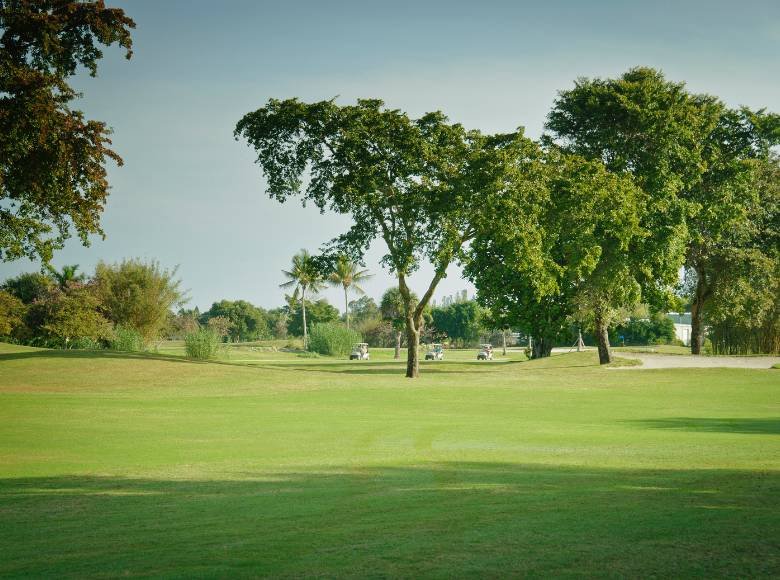The tips to cultivate and nurture course landscapes in Florida include embracing native plant species, developing a comprehensive landscaping plan, optimizing water management, prioritizing soil health, implementing Integrated Pest Management, to name a few.
Golf courses in Florida are more than just places for swinging clubs and sinking putts. They are living canvases where nature’s beauty intertwines with the pursuit of sport. To ensure that these landscapes remain lush, vibrant, and ecologically balanced, proper cultivation and nurturing practices are paramount.
In this article, we’ll explore ten essential tips that will guide Florida’s golf course managers in achieving impeccable course landscapes.
1. Embrace Native Plant Species
Native plants are the backbone of an ecologically balanced golf course. These species are well adapted to Florida’s climate, requiring less water and minimal maintenance. Incorporating them into the landscape not only enhances biodiversity but also reduces water consumption and maintenance costs.
By choosing native plants, golf course managers tap into a wealth of advantages that positively impact both the environment and the course’s aesthetics. Native species have developed a natural resilience to the challenges posed by the region’s weather patterns, pests, and diseases. This intrinsic hardiness translates into reduced maintenance requirements, as native plants generally demand less water and fewer chemical interventions.
2. Develop a Comprehensive Landscape Plan
A well-thought-out landscape plan is the foundation of successful cultivation. Consider factors such as terrain, soil quality, and sunlight exposure. By intimately understanding these elements, golf course managers can strategically position features like bunkers, water hazards, and tee boxes to maximize both playability and visual aesthetics.
Craft a plan that maximizes the course’s natural attributes while minimizing potential environmental impacts. This plan serves as a blueprint, guiding golf course managers through the intricate process of designing and nurturing a landscape that harmonizes with Florida’s unique environment. The importance of this step cannot be overstated, as it lays the foundation for an enduring and well-balanced course that resonates with players and nature enthusiasts alike.
3. Optimize Water Management
Florida’s climate demands effective water management. Efficient irrigation not only ensures the survival of the turf but also contributes to the course’s ecological balance and operational efficiency.
The heart of optimizing water management lies in the implementation of sophisticated irrigation systems that provide precise and targeted hydration to the landscape. By investing in advanced technology such as smart controllers, golf course managers can calibrate watering schedules based on real-time weather data. This intelligent approach prevents the wasteful overwatering that often results from fixed irrigation schedules, conserving water and reducing operational costs.
4. Prioritize Soil Health

Prioritizing soil health emerges as a fundamental pillar in the cultivation and nurturing of golf course landscapes that stand resilient against the challenges of climate, play, and maintenance. A thriving landscape begins with the soil, and by fostering its well-being, golf course managers lay the groundwork for lush greens and a sustainable environment.
To prioritize soil health, a multifaceted approach is required. Regular soil testing and analysis offer insights into the soil’s composition, nutrient levels, and pH balance. Armed with this knowledge, golf course managers can tailor fertilization practices to provide the precise nutrients needed for optimal plant growth. Incorporating organic matter, such as compost, into the soil structure augments its ability to retain moisture, enhance nutrient availability, and improve overall drainage. This, in turn, contributes to robust root systems and lush vegetation.
5. Integrated Pest Management (IPM)
Pest management is a delicate balance between aesthetics and ecology. Adopt an IPM approach that utilizes a combination of cultural practices, biological controls, and minimal chemical intervention. Golf course managers leverage the natural predators and biological controls that coexist within the ecosystem to regulate pest populations. This approach protects the landscape’s health while minimizing harm to beneficial insects and wildlife.
6. Sustainable Fertilization Practices
Applying fertilizers judiciously is vital for optimal growth. Utilize slow-release fertilizers that release nutrients gradually over time, reducing the risk of nutrient runoff and contamination of water bodies. Tailor fertilization schedules to match the specific needs of each area on the course.
7. Bunker Maintenance
Maintaining bunkers is an art that requires precision. Regularly aerate sand traps to prevent compaction and improve drainage. Choose appropriate bunker sand that promotes playability while minimizing sand migration during storms.
8. Tree and Shrub Management
Trees and shrubs add character to the course but require careful maintenance. Regular pruning, trimming, and monitoring for pests and diseases are essential. Preserve mature trees whenever possible, as they provide shade, shelter, and habitat for wildlife.
9. Efficient Waste Management
A sustainable landscape involves responsible waste disposal. Implement a composting program to recycle grass clippings and organic debris, reducing landfill waste. Proper waste management not only benefits the environment but also enriches soil quality.
10. Educate Staff and Golfers
Cultivation and nurturing efforts extend beyond groundskeepers. Educate course staff and golfers about the importance of responsible practices. Encourage them to repair ball marks, replace divots, and follow cart path rules to minimize turf damage.
Cultivating and nurturing golf course landscapes in Florida is a harmonious blend of science, art, and environmental stewardship. By adhering to these ten essential tips, golf course managers can ensure that their courses remain showcases of natural beauty, ecological balance, and sustainable practices. These landscapes not only provide exceptional playing experiences but also contribute to Florida’s rich ecological diversity and vibrant outdoor lifestyle.
If you’re ready to elevate your golf course to unparalleled levels of excellence, it’s time to consider the expertise of DTE Golf®. Our commitment to innovative and sustainable course management practices makes us the perfect partner for cultivating and nurturing landscapes that harmonize nature’s beauty with top-tier playability. Contact us today for a consultation.
